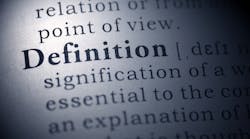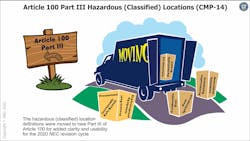Knowing the definitions found in the National Electrical Code (NEC) is crucial to comprehending the various electrical code requirements. Without this understanding, mistakes can be made in electrical installations and applications.
Take, for example, the subject of grounding and bonding. Throughout the electrical industry, the use of the term “ground conductor” is substituted by many in place of one of the defined terms, such as equipment grounding conductor (EGC), grounding electrode conductor (GEC), supply-side bonding jumper, etc. Without an understanding of the appropriate definition for each of these items, how can the appropriate Code sections and tables be applied accurately? Better yet, consider the following statement regarding this topic: Without a proper understanding of the proper term being used, often we find the installer talking “apples” and the inspector talking “oranges.”
Article 100 ― Definitions
Many NEC definitions are located in Art. 100. The Code has been structured in this manner for many editions. However, some people in the industry are unaware that not all definitions in the NEC are located in Art. 100. If you were to depend solely on this Article for definitions, you would be missing several more found throughout the NEC. The Code Making Panels did us all a favor when locating definitions in various Articles of the Code. They placed them in the “.2” sections of a particular Article so that a consistent location or placeholder made it more user-friendly when searching Articles that include definitions. An example of this would be found at Sec. 680.2 in the 2020 NEC where 27 definitions on swimming pools, spas, etc., reside.
A change took place for the 2020 NEC code cycle that is worth noting. A new Part III was added to Art. 100 as a placeholder for the definitions previously found in Art. 500 dealing with Hazardous (Classified) Locations (see the Figure below).
Code Making Panel No. 14 (CMP-14) made this decision and may have also unknowingly opened a Pandora’s box for even more changes to the upcoming 2023 NEC.
Another clarification brought forward in this same Code cycle concerned the application of definitions found in Articles of the NEC. Two distinct statements were added at the “.2” sections of those Articles containing definitions. The first states the definitions in this Article apply only within this Article. The other stipulates that the definitions in this Article apply within this Article and throughout the Code. This language was needed to help users of the Code understand how and where these definitions were intended to apply and be used.
2023 NEC possibilities
As mentioned earlier, CMP-14 may have started a movement in their action to create Part III of the 2020 NEC. However, Part III may also have a short life and only appear in the 2020 edition of the NEC. What I mean by this is that if actions remain as proposed from the NFPA First Draft meetings, all definitions will be relocated from the “.2” sections of various Articles and placed in Art. 100. The three parts that are currently in Art. 100 will no longer exist. Instead, there will be more than 800 definitions located in alphabetical order within this Article. For many of the definitions proposed for the 2023 NEC, there will appear something like “(547)” meaning that particular definition will have an application in Art. 547 of the 2023 NEC.
Many argue this has been a long time coming. Others, especially CMP members, may feel as if they are losing control over definitions that are (and have been) under their purview. This was an unfounded concern as one of the changes that happened during the 2017 NEC code cycle was to add in parenthesis at the end of the definition(s), indicating which CMP had purview over that particular definition. This has seemed to allay the concerns of many and allowed the movement of these definitions from their “.2” placeholders to Art. 100 in the hopes of making the NEC more user-friendly.
This change also helps align the NEC with its own NEC Style Manual, which gives guidance and direction as to how the information within and throughout this document should be presented. The NEC Style Manual was updated and revised, which required the definitions to be relocated to Art. 100. NEC Style Manual Task Group Chairman David Williams worked with various other task group members on his committee to review the NEC in its entirety to ensure information included in the 2023 NEC followed the requirements of the Style Manual.
Just another thing to keep up with
One thing users of the Code will need to remember is what edition of the NEC they are using regarding where to locate the various definitions. If things hold as proposed for the 2023 NEC, any edition before 2023 will have definitions located in Art. 100 and also within the “.2” sections of various Articles. For the 2023 NEC and possibly beyond, all definitions will be located in Art. 100.
Some individuals will be popping corks and toasting that this long-time goal has been achieved. On the other hand, some might have some legitimate concerns as to whether or not a definition developed specifically for use in a particular Article will work for use throughout the NEC. This will be the responsibility of future CMP members because they will be the ones addressing these and other issues in the upcoming Code revision cycles.
Joseph Wages, Jr., is the director of digital education at IAEI. Previously he has held the positions of technical advisor, education, codes and standards, and seminar coordinator at IAEI. He represents IAEI on NFPA’s NEC Code-Making Panel No. 2 for the 2020 and 2023 NEC code cycles. He previously represented IAEI on NFPA’s NEC Code-Making Panel No. 3 for the 2014 and 2017 NEC. He serves on the Underwriters Laboratories (UL) Electrical Council and several UL technical standard panels. He can be reached at [email protected].
Inspector Intel articles are provided by the International Association of Electrical Inspectors (IAEI), a membership-driven, non-profit association headquartered in Richardson, Texas, that promotes electrical safety throughout the industry by providing education, certification of inspectors, advocacy, partnerships, and expert leadership in electrical codes and standards.www.iaei.org




